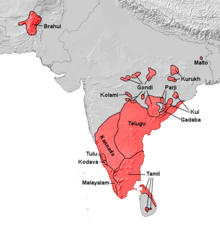Brahui people
|
A photograph from 1910 with the caption reading "Brahui of Quetta". | |
| Languages | |
|---|---|
|
Brahui Balochi, Sindhi, Urdu, Arabic, Persian spoken as second languages | |
| Religion | |
| Sunni Islam (Hanafi) | |
| Related ethnic groups | |
| Dravidian people of South India, Nearby Balochis |
| Part of a series on |
| Dravidian culture and history |
|---|
 |
|
History |
|
Regions
|
|
People |
| Portal:Dravidian civilizations |
The Brahui (Brahui: براہوئی,) or Brahvi people are an ethnic group of about 2.2 million people with the vast majority found in Baluchistan, Pakistan as well as Afghanistan, where they are native, but they are also found through their diaspora in Middle Eastern states.[1] They mainly occupy the area in Balochistan from Bolan Pass through the Bolan Hills to Ras Muari (Cape Monze) on the Arabian sea, separating the Baloch people living to the east and west.[2][3] The Brahuis are almost entirely Sunni Muslims.[4]
Origins
The ethnonym "Brahui" is a very old term and a purely Dravidian one.[5] The fact that other Dravidian languages only exist further south in India has led to several speculations about the origins of the Brahui. There are three hypotheses regarding the Brahui that have been proposed by academics. One theory is that the Brahui are a relict population of Dravidians, surrounded by speakers of Indo-Iranian languages, remaining from a time when Dravidian was more widespread. Another theory is that they migrated to Baluchistan from inner India during the early Muslim period of the 13th or 14th centuries.[6] A third theory says the Brahui migrated to Balochistan from Central India after 1000 AD. The absence of any older Iranian (Avestan) influence in Brahui supports this last hypothesis. The main Iranian contributor to Brahui vocabulary is a northwestern Iranian language, Baluchi, Sindhi and southeastern Iranian language, Pashto.[7]
The History of the Brahui emerges from total darkness with the displacement of a shadowy Hindu dynasty in Kalat called Sewa by the Mirwani Brahuis. There is a Mughal interlude and then Brahui ascendancy again.[8]
It is said that a Hindu dynasty, the Sewa by name, ruled over this part of the country prior to the seventh century, Kalat is still known as Kalat-i-Sewa.[9]
Brahui speaking Baloch tribes include Mohammad Hassani, Yagizehi, Mengal, Natwani, Lehri, Zagar Mengal, Mirwani, Bangulzai, Banulzai, Kheazai, Sarparah, Muhammad Shahi, Kurd, Meskanzai (Sarparah), Sumulani, Zarakzai (Zehri), Sasoli, Sataksai, Qambarani, Rodeni, Pandrani, Jattak.[10]
Language
The Brahui language is a Dravidian language, even though its homeland is very far from South India. It is mainly spoken in the Kalat areas of Balochistan, Pakistan, and in Southern Afghanistan, as well as by an unknown very small number of expatriates in the Gulf states, Turkmenistan, as well as Iranian Balochistan.[11] It has three dialects: Sarawani (spoken in the north), Jhalawani (spoken in the southeast), and Chaghi (spoken in the northwest and west) The 2013 edition of Ethnologue reports that there are some 4.2 million speakers; 4 million live in Pakistan, mainly in the province of Balochistan. Due to its isolation, Brahui's vocabulary is only 15% Dravidian, while the remainder is dominated by Balochi, and Indo-Aryan languages (for example, of the number names from "one" to "ten," "four" through "ten" are borrowed from Persian. Brahui is generally written in the Perso-Arabic script and there is even a Latin alphabet that has been developed for use with Brahui.
Dialects
Kalat, Jhalawan, and Sarawan, with Kalat as the standard dialect.
At present Brahui is spoken in Pakistani Balochistan, Afghanistan, Turkmenistan, Sindh and the Persian Gulf Arab states.
Genetics
Brahuis display a variety of Y-DNA haplogroups, the two most important being haplogroup R1a - with its mass diffusion among populations of Central/South Asia and associated with the early eastern migrations of Indo-Iranian nomads - and haplogroup J, which, though found among other subcontinental peoples, is nevertheless more typical of Near-Eastern populations.[12][13] Other, relatively minor, low-frequency haplogroups among the Brahui are those of L, E1b1a, G, and N.[12][13]
References
- ↑ James B. Minahan. "Brahuis". Ethnic Groups of South Asia and the Pacific: An Encyclopedia. Retrieved 21 November 2015.
- ↑ Shah, Mahmood Ali (1992), Sardari, jirga & local government systems in Balochistan, Qasim Printers, pp. 6–7
- ↑ Minahan, James B. (31 August 2016), "Brahui", Encyclopedia of Stateless Nations: Ethnic and National Groups around the World, 2nd Edition: Ethnic and National Groups around the World, ABC-CLIO, pp. 79–80, ISBN 978-1-61069-954-9
- ↑ Dictionary of Languages: The Definitive Reference to More Than 400 Languages. Columbia University Press. 2004-03-01. ISBN 9780231115698. Retrieved 2010-09-09.
- ↑ Brahui, a Dravidian language: a descriptive and comparative study. Foreign Language Study. Retrieved 2010-09-09.
- ↑ [Sergent, Genèse de l'Inde]
- ↑ J. H. Elfenbein, A periplous of the ‘Brahui problem’, Studia Iranica vol. 16 (1987), pp. 215-233.
- ↑ Language and linguistic area: essays By Murray Barnson Emeneau, Selected and introduced by Anwar S. Dil, Stanford University Press. Page 334
- ↑ Population Census Organisation, Statistics Division, Govt. of Pakistan, 1999, 1998 district census report of Kalat Page 7.
- ↑ Shahwani Raisani Mulazai, Mohammadzai (Mengal)Infrastructure Project Development Facility: Balochistan Archived January 6, 2009, at the Wayback Machine.
- ↑ https://books.google.com/books?id=bCkaAQAAIAAJ
- 1 2 Raheel, Qamar; et al. (2002). "Y-Chromosomal DNA Variation in Pakistan". American Journal of Human Genetics. 70: 1107–1124. doi:10.1086/339929. PMC 447589
 . PMID 11898125.
. PMID 11898125. - 1 2 Sengupta, S; Zhivotovsky, LA; King, R; Mehdi, SQ; Edmonds, CA; Chow, CE; Lin, AA; Mitra, M et al. (2006).
External links
| Wikimedia Commons has media related to Brahui. |
| Wikisource has the text of the 1911 Encyclopædia Britannica article Brahui. |
- South Asia Language Resource Center
- Brahui people, Britannica.com
- Qamar, Raheel; Ayub, Qasim; Mohyuddin, Aisha; Helgason, Agnar; Kehkashan, Mazhar; Atika, Mansoor; Zerjal, Tatjana; Tyler-Smith, Chris; Mehdi, S. Qasim (2002-03-15). "Y-Chromosomal DNA Variation in Pakistan". American Journal of Human Genetics. 70 (5): 1107–1124. doi:10.1086/339929. PMC 447589
 . PMID 11898125.
. PMID 11898125.
